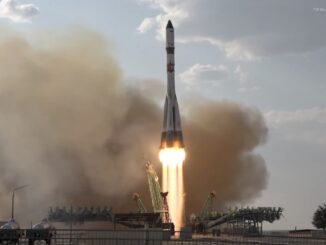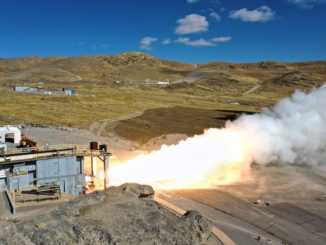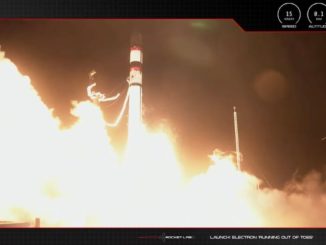The Russian Progress MS-16 cargo freighter rolled out to its launch pad Friday at the Baikonur Cosmodrome in Kazakhstan, its final stop before blastoff Sunday night with more than 5,000 pounds of fuel, food, and water for the International Space Station.
Enclosed inside the payload shroud of its Soyuz-2.1a launcher, the Progress supply ship emerged from the the Soyuz integration hangar at Baikonur and moved to the Site 31 launch complex. A hydraulic lift raised the rocket vertical on the launch pad, and swing arms folded into position around the launcher to provide access for ground teams to complete final preflight preparations.
Russian managers will meet about five hours before launch to give approval for loading kerosene and liquid oxygen propellants into the Soyuz-2.1a rocket, setting the stage for liftoff at 11:45:06 p.m. EST Sunday (0445:06 GMT; 10:45:06 a.m. Baikonur time).
Heading northeast from historic spaceport in Kazakhstan, the Soyuz rocket’s four first stage boosters will shut down their RD-107A engines and jettison around two minutes after liftoff, while a four-nozzle RD-108A engine on the core stage continues firing. A protective aerodynamic shroud will then fall away from the top of the rocket to reveal the Progress MS-16 spacecraft after reaching space.
The core stage will shut down and separate nearly five minutes after liftoff, giving way to an RD-0110 engine on the Soyuz third stage to inject the Progress freighter into orbit. Separation of the Progress cargo craft from the Soyuz third stage is scheduled nearly nine minutes into the mission.
Moments after separation, the Progress will unfurl its two power-generating solar array wings and navigation antennas. Russian ground controllers will oversee a sequence of thruster burns to align the cargo ship’s orbit with that of the space station, positioning the Progress freighter for docking with the Pirs module on the orbiting research lab at 1:20 a.m. EST (0620 GMT) Wednesday.
The Progress MS-16 spacecraft is loaded with around 5,424 pounds, or 2,460 kilograms, of cargo and supplies for the space station and its seven-person crew, according to Roscosmos, the Russian space agency.
The freighter’s payload includes about 3,086 pounds, or 1,400 kilograms, of dry cargo packed inside the Progress spacecraft’s pressurized compartment. There’s also 1,322 pounds, or 600 kilograms, of propellant to be fed into the space station’s Zvezda service module propulsion system, according to Roscosmos, along with 926 pounds (420 kilograms) of fresh water and 89 pounds (40.5 kilograms) of pressurized gases to supplement the space station’s breathable atmosphere.

The mission will be the 77th launch of a Progress supply ship to the International Space Station since 2000. The previous Progress cargo ship, Progress MS-15, undocked from the space station Feb. 9 and made a destructive re-entry into the atmosphere, getting rid of trash and clearing the way for the arrival of fresh cargo delivery.
The Progress MS-16 spacecraft will also carry equipment to help cosmonauts detect and patch leaks on the space station, plus Russian biomedical experiments and a research payload to study obtaining food and oxygen from algae in microgravity, Roscosmos said.
The supply ship will remain at the space station until July, when the Progress is scheduled to depart with the Pirs docking compartment in tow. The Progress MS-16 will guide itself, along with the disused Pirs module, back into the atmosphere to burn up at the end of its mission.
The Pirs module has served as a docking port and an airlock for cosmonauts on spacewalks since 2001. A similar module named Poisk serves a similar function, and will remain at the space station.
The removal of the Pirs module clears a docking port on the Zvezda service module, the central hub of the space station’s Russian segment, for the arrival of the long-delayed Nauka laboratory later this year. The Nauka lab module will be the largest addition to the Russian segment of the station since 2000, when Zvezda itself was launched.
More photos of the rollout of the Soyuz rocket Friday are posted below.


















Email the author.
Follow Stephen Clark on Twitter: @StephenClark1.



